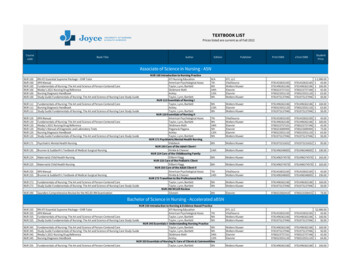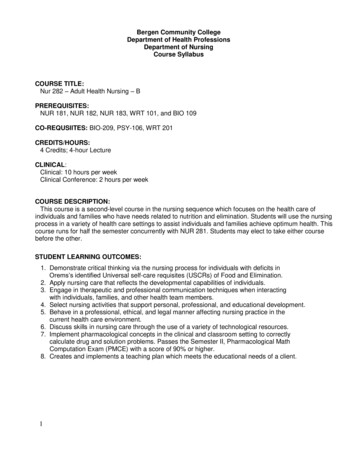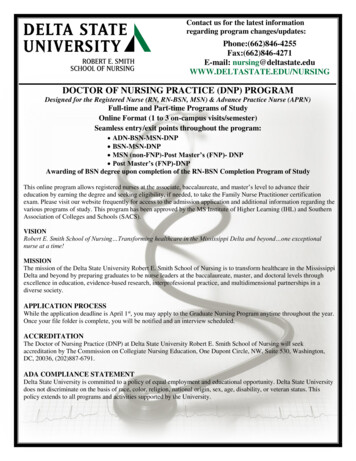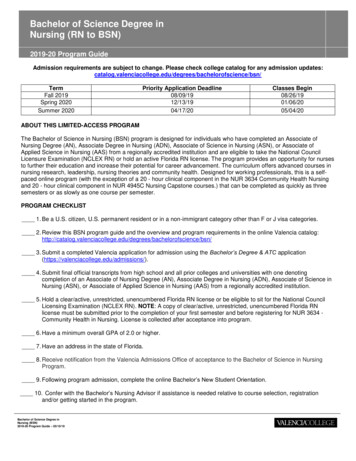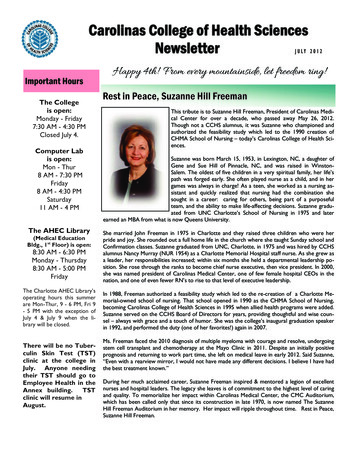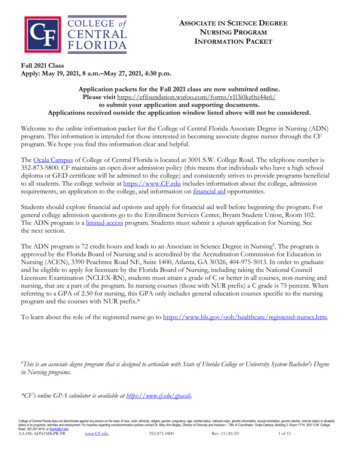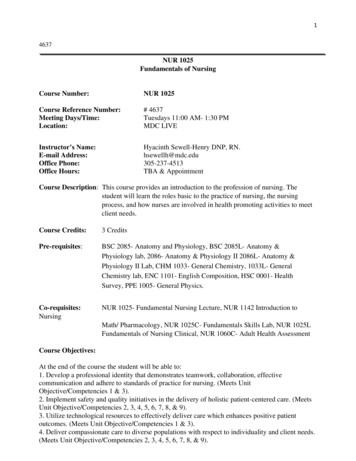
Transcription
14637NUR 1025Fundamentals of NursingCourse Number:NUR 1025Course Reference Number:Meeting Days/Time:Location:# 4637Tuesdays 11:00 AM- 1:30 PMMDC LIVEInstructor’s Name:E-mail Address:Office Phone:Office Hours:Hyacinth Sewell-Henry DNP, RN.hsewellh@mdc.edu305-237-4513TBA & AppointmentCourse Description: This course provides an introduction to the profession of nursing. Thestudent will learn the roles basic to the practice of nursing, the nursingprocess, and how nurses are involved in health promoting activities to meetclient needs.Course Credits:3 CreditsPre-requisites:BSC 2085- Anatomy and Physiology, BSC 2085L- Anatomy &Physiology lab, 2086- Anatomy & Physiology II 2086L- Anatomy &Physiology II Lab, CHM 1033- General Chemistry, 1033L- GeneralChemistry lab, ENC 1101- English Composition, HSC 0001- HealthSurvey, PPE 1005- General Physics.Co-requisites:NursingNUR 1025- Fundamental Nursing Lecture, NUR 1142 Introduction toMath/ Pharmacology, NUR 1025C- Fundamentals Skills Lab, NUR 1025LFundamentals of Nursing Clinical, NUR 1060C- Adult Health AssessmentCourse Objectives:At the end of the course the student will be able to:1. Develop a professional identity that demonstrates teamwork, collaboration, effectivecommunication and adhere to standards of practice for nursing. (Meets UnitObjective/Competencies 1 & 3).2. Implement safety and quality initiatives in the delivery of holistic patient-centered care. (MeetsUnit Objective/Competencies 2, 3, 4, 5, 6, 7, 8, & 9).3. Utilize technological resources to effectively deliver care which enhances positive patientoutcomes. (Meets Unit Objective/Competencies 1 & 3).4. Deliver compassionate care to diverse populations with respect to individuality and client needs.(Meets Unit Objective/Competencies 2, 3, 4, 5, 6, 7, 8, & 9).
25. Uses relevant evidence to improve client outcomes within a dynamic environment. (Meets UnitObjective/Competencies 2, 4, 5, 6, 7, 8, & 9).Unit Course Competencies/Objectives/EPSLO/MDC Learning Outcomes/Core ComponentsCourse ContentLearning Outcomes Unit 1: Contemporary Nursing Practice Unit 1 Competencies1. Identify the concepts of health, health care delivery and thesettings and resources available in the community.2. Discuss the roles of the registered professional nurse3. Identify roles of the members of the health care teamincluding physician, social worker, case manager, dietitian,physical therapist, respiratory therapist, licensed practicalnurse, and unlicensed assistive personnel4. Discuss interactions between the registered professional nurseand other members of the health team.Unit 1 Contenta.b.c.d.e.f.Health and healthcare deliveryVarious settings that provide health care servicesFactors affecting health care delivery.Roles of various members of the health care team.Frameworks for health care delivery.Teamwork and collaborationUnit 1 EPSLOEPSLO 1: Develop a professional identity that demonstratesteamwork, collaboration, effective communication and adhere tostandards of practice for nursing. (MDC Learning Outcomes 1,6)(Core Components 3, 4 & 6) Identify professional standards of nursing practice that guidepractice.Display professional accountability and responsibility inclassroom and laboratory settings.Describe how ethical principles and legal tenets guide nursingpractice.Critical/creativethinkingFormulate strategiesEthics
3 Describe how regulatory guidelines and institution policiesguide nursing practiceUnit 2 – Nursing Process and Critical thinkingUnit 2 Competencies1. Identify the phases of the nursing process.2. Personalize the nursing care plan to meet individualclient needs.3. Interpret assessment data and utilize evidencebased interventions.4. Demonstrate clinical decision-making, critical thinking,and prioritization.5. Integrate principles of teaching-learning with thephases of the nursing process.6. Identify the components of the critical thinking model7. Compare the relationship between critical thinking andthe nursing processUnit 2 Contenta.b.c.d.e.Phases of the nursing process.Personalizing the nursing care planInterpreting assessment dataUtilize evidence-based interventions.Clinical decision-making, critical thinking, andprioritization.f. Principles of teaching-learningUnit 2 EPSLOEPSLO 4: Deliver compassionate care to diverse populations withrespect to individuality and client needs. (MDC Learning Outcomes1, 2) (Core Components 1, 2, & 7)EPSLO 5: Uses relevant evidence to improve client outcomes withina dynamic environment. (MDC Learning Outcomes 2,4,9,10) (CoreComponents 5 & 7) Perform a comprehensive health assessment includingphysiological, psychological, sociological, and spiritual needsof patients, families, groups, populations, and communitiesacross the lifespan experiencing complex (unstable acuteconditions) health alterations in a variety of settings.Use the nursing process to prioritize the delivery of patientcare, with two or more patients, to achieve optimal outcomes.Model culturally sensitive care for patients, families, andgroups from diverse backgrounds.Use clinical reasoning and clinical judgment when evaluatingnursing care to improve patient outcomes.Advocate for patients, families, and groups regarding nursingcare issues and health care decisions. Quantitative analytical Critical/creative thinking Formulate strategies
4 Use verbal and nonverbal communication that promotescaring, therapeutic relationships with individuals, families,and groups.Analyze best current evidence for its application to practicewhen providing and managing patient-centered care.Integrate best current evidence into clinical judgments thatindicate the need to modify clinical practiceUnit 3 – Professional Nursing and RolesUnit 3 Competencies1. Discuss the role of the nurse as educator,advocate, collaborator, and manager of care.2. Explain independent, dependent and collaborative/interdependent functions of the professional nurse.3. Recognize the nurse’s role in identifying and reportingmedical errors4. Analysis cause of sentinel events5. Differentiate between active and latent errorsUnit 3 Contenta. Role of the nurse as educator, advocate,collaborator, and manager of care.b. Independent, dependent and collaborative/ interdependentfunctions of the professional nurse.c. Sentinel events – root cause analysisd. Types of errors - (medication, latent, active)e. Reporting of errorsUnit 3 EPSLOEPSLO1: Develop a professional identity that demonstratesteamwork, collaboration, effective communication and adhere tostandards of practice for nursing. (MDC Learning Outcomes 1,6)(Core Components 3, 4 & 6) Identify professional standards of nursing practice that guidepractice.Display professional accountability and responsibility inclassroom and laboratory settings.Describe how ethical principles and legal tenets guide nursingpractice. Critical/creative thinking Formulate strategies
5 Describe how regulatory guidelines and institution policiesguide nursing practiceEPSLO 4: Deliver compassionate care to diverse populations withrespect to individuality and client needs. (MDC Learning Outcomes1, 2) (Core Components 1, 2, & 7)EPSLO 5: Uses relevant evidence to improve client outcomes withina dynamic environment. (MDC Learning Outcomes 2,4,9,10) (CoreComponents 5 & 7) Perform a comprehensive health assessment includingphysiological, psychological, sociological, and spiritual needsof patients, families, groups, populations, and communitiesacross the lifespan experiencing complex (unstable acuteconditions) health alterations in a variety of settings.Use the nursing process to prioritize the delivery of patientcare, with two or more patients, to achieve optimal outcomes.Model culturally sensitive care for patients, families, andgroups from diverse backgrounds.Use clinical reasoning and clinical judgment when evaluatingnursing care to improve patient outcomes.Advocate for patients, families, and groups regarding nursingcare issues and health care decisions.Use verbal and nonverbal communication that promotescaring, therapeutic relationships with individuals, families,and groups.Analyze best current evidence for its application to practicewhen providing and managing patient-centered care.Integrate best current evidence into clinical judgments thatindicate the need to modify clinical practiceUnit 4 – Values ClarificationUnit 4 Competencies1. Define the concept of holistic being2. Identify the interrelated physiological, psychologic,sociocultural, spiritual, and environmental dimensions of theclient3. Discuss the concept of delivering culturally competent care4. Identify the impact of cultural diversity on the delivery ofhealth care. Quantitative analytical Critical/creative thinking
6Unit 4 Contenta.b.c.d.Holistic BeingCultural diversityCulturally CompetentBio-psycho-social beingUnit 4 EPSLOEPSLO 4: Deliver compassionate care to diverse populations withrespect to individuality and client needs. (MDC Learning Outcomes1, 2) (Core Components 1, 2, & 7)EPSLO 5: Uses relevant evidence to improve client outcomes withina dynamic environment. (MDC Learning Outcomes 2,4,9,10) (CoreComponents 5 & 7) Perform a comprehensive health assessment includingphysiological, psychological, sociological, and spiritualneeds of patients, families, groups, populations, andcommunities across the lifespan experiencing complex(unstable acute conditions) health alterations in a variety ofsettings.Use the nursing process to prioritize the delivery of patientcare, with two or more patients, to achieve optimal outcomes.Model culturally sensitive care for patients, families, andgroups from diverse backgrounds.Use clinical reasoning and clinical judgment when evaluatingnursing care to improve patient outcomes.Advocate for patients, families, and groups regarding nursingcare issues and health care decisions.Use verbal and nonverbal communication that promotescaring, therapeutic relationships with individuals, families,and groups.Analyze best current evidence for its application to practicewhen providing and managing patient-centered care.Integrate best current evidence into clinical judgments thatindicate the need to modify clinical practiceUnit 5 - Therapeutic communication/ Teaching -Learning Process CommunicationQuantitative analyticalCritical/creative thinkingFormulate strategiesCulture
7Unit 5 Competencies1. Explain the elements of the communication process2. Distinguish therapeutic, non-therapeutic and socialcommunication3. Discuss teaching and learning with respect to thecommunication process4. Integrate principles of teaching and learning with the phasesof the nursing processUnit 5 contenta. Process of communicationb. Therapeutic, non-therapeutic, and social communication.c. Teaching-Learning processd. Teaching-Learning and the nursing processUnit 5 EPSLOEPSLO 4: Deliver compassionate care to diverse populations withrespect to individuality and client needs. (MDC Learning Outcomes1, 2) (Core Components 1, 2, & 7)EPSLO 5: Uses relevant evidence to improve client outcomes withina dynamic environment. (MDC Learning Outcomes 2,4,9,10) (CoreComponents 5 & 7) Perform a comprehensive health assessment includingphysiological, psychological, sociological, and spiritualneeds of patients, families, groups, populations, andcommunities across the lifespan experiencing complex(unstable acute conditions) health alterations in a variety ofsettings.Use the nursing process to prioritize the delivery of patientcare, with two or more patients, to achieve optimal outcomes.Model culturally sensitive care for patients, families, andgroups from diverse backgrounds.Use clinical reasoning and clinical judgment when evaluatingnursing care to improve patient outcomes.Advocate for patients, families, and groups regarding nursingcare issues and health care decisions.Use verbal and nonverbal communication that promotescaring, therapeutic relationships with individuals, families,and groups.Analyze best current evidence for its application to practicewhen providing and managing patient-centered care.
8 Integrate best current evidence into clinical judgments thatindicate the need to modify clinical practiceUnit 6 - Client Centered Care – Physical (general)Unit 6 Competencies1. Discus the components of health history.2. Discuss factors that influence or impact:a. Oxygenationb. Immobilityc. Bowel eliminationd. Urinary eliminatione. Nutritionf. Skin integrity and wound careg. Pain and comfortsh. Fluids, electrolytes, and acid-base balancei. Sensory perceptionj. Infection prevention and controlk. Surgical asepsisl. The surgical client - preoperative, intraoperative,and postoperative phasesUnit 6 Contenta. Body mechanics, ergonomics and mobilityb. Oxygenation; immobility; activity and rest; bowelelimination; urinary elimination; nutrition; skin integrityand wound care; pain and comfort; fluids, electrolytes, andacid-base balance; sensory perception; hygiene; infectionprevention and control; surgical asepsisc. Needs of surgical client - preoperative, intraoperative, andpostoperative phasesUnit 6 EPSLOEPSLO 4: Deliver compassionate care to diverse populations withrespect to individuality and client needs. (MDC Learning Outcomes1, 2) (Core Components 1, 2, & 7)EPSLO 5: Uses relevant evidence to improve client outcomes withina dynamic environment. (MDC Learning Outcomes 2,4,9,10) (CoreComponents 5 & 7) Quantitative analytical Critical/creative thinking Formulate strategies
9 Perform a comprehensive health assessment includingphysiological, psychological, sociological, and spiritualneeds of patients, families, groups, populations, andcommunities across the lifespan experiencing complex(unstable acute conditions) health alterations in a variety ofsettings.Use the nursing process to prioritize the delivery of patientcare, with two or more patients, to achieve optimal outcomes.Model culturally sensitive care for patients, families, andgroups from diverse backgrounds.Use clinical reasoning and clinical judgment when evaluatingnursing care to improve patient outcomes.Advocate for patients, families, and groups regarding nursingcare issues and health care decisions.Use verbal and nonverbal communication that promotescaring, therapeutic relationships with individuals, families,and groups.Analyze best current evidence for its application to practicewhen providing and managing patient-centered care.Integrate best current evidence into clinical judgments thatindicate the need to modify clinical practiceUnit 7 - Client Centered Care – PsychosocialUnit 7 Competencies1. Describe the physiological and psychological responses tostress.2. Discuss the concepts death and dying.3. Explain special needs of the aging client4. Identify client needs throughout the life cycle5. Discuss the legal and ethical implications in end of life care.Unit 7 Contenta.b.c.d.e.f.Stress and adaptationCoping mechanismsDeath and dying.Aging clientLife cycle needsEnd of Life careUnit 7 EPSLO Communicate Critical/creative thinking Formulate strategies
10EPSLO 4: Deliver compassionate care to diverse populations withrespect to individuality and client needs. (MDC Learning Outcomes1, 2) (Core Components 1, 2, & 7)EPSLO 5: Uses relevant evidence to improve client outcomes withina dynamic environment. (MDC Learning Outcomes 2,4,9,10) (CoreComponents 5 & 7) Perform a comprehensive health assessment includingphysiological, psychological, sociological, and spiritualneeds of patients, families, groups, populations, andcommunities across the lifespan experiencing complex(unstable acute conditions) health alterations in a variety ofsettings.Use the nursing process to prioritize the delivery of patientcare, with two or more patients, to achieve optimal outcomes.Model culturally sensitive care for patients, families, andgroups from diverse backgrounds.Use clinical reasoning and clinical judgment when evaluatingnursing care to improve patient outcomes.Advocate for patients, families, and groups regarding nursingcare issues and health care decisions.Use verbal and nonverbal communication that promotescaring, therapeutic relationships with individuals, families,and groups.Analyze best current evidence for its application to practicewhen providing and managing patient-centered care.Integrate best current evidence into clinical judgments thatindicate the need to modify clinical practice
Unit 8 - Client-Centered Care – Safety Quantitativeanalytical Critical/creativethinking Formulate strategiesUnit 8 Competencies1. Define the concept of patient safety.2. Discuss personal and environmental factors that impair apatient’s ability to protect themselves from injury.3. Review interventions that can assist in reducing risk ofpatient injury:a. properly identifying patient,b. using six rights of medication administration,c. performing fall risk assessment,d. communicating patient information toappropriate team member.4. Discuss how proper and effective use of technology andstandardized policies and procedures support safe,quality care.5. Recognize the role of the nurse in monitoring own careand that of others in promoting a safe environment forthe patient.Unit 8 Contenta.b.c.d.e.f.g.h.Safe MedicationFall risk assessment/preventionCommunication of patient safety riskStandardized policies and proceduresRestraintsFire SafetyEnvironmental SafetyInfection controlUnit 8 EPSLOEPSLO 2: Implement safety and quality initiatives in the deliveryof holistic client-centered care. (MDC Learning Outcomes 3)(Core Component 5 & 7) Anticipate safety risks to patients, self and others inhealthcare, home, and community settingsImplement actions that minimize safety risks andenvironmental hazards in healthcare settings.Unit 9 - Client-Centered Care – Body Equilibrium Quantitativeanalytical11
12 Critical/creativethinking Formulate strategiesUnit 9 Competencies1. Describe the physiological processes involved innormal vision and hearing.2. Identify common abnormalities of the visual andauditory systems.3. Review interventions for managing the care of clientswith selected visual and auditory pathologies,4. Describe the role of fluid and electrolytes in bodyfunction5. Compare signs and symptoms of specific fluid andelectrolyte imbalances6. Identify nursing management of specific fluid andelectrolyte imbalances7. Compare and contrasting types of intravenous solutionsand indications for use8. Describe pH and the mechanisms that regulate acidbase balance9. Analyze arterial blood gases10. Identify normal and abnormal manifestations ofrespiratory and metabolic acidosis and alkalosisUnit 9 Contenta.b.c.d.Assessing hearing and visionCommon disorders of vison and hearingIntervention for vision and hearing conditionsFluid and electrolytes – labs, IV fluids, hyper and hypoconditionse. Acid-base balance – labs, compensation, acidosis, andalkalosisf. Arterial blood gasUnit 9 EPSLOEPSLO 2: Implement safety and quality initiatives in the deliveryof holistic client-centered care. (MDC Learning Outcomes 3)(Core Component 5 & 7) Anticipate safety risks to patients, self and others inhealthcare, home, and community settingsImplement actions that minimize safety risks andenvironmental hazards in healthcare settings.
13EPSLO 4: Deliver compassionate care to diverse populations withrespect to individuality and client needs. (MDC LearningOutcomes 1, 2) (Core Components 1, 2, & 7)EPSLO 5: Uses relevant evidence to improve client outcomeswithin a dynamic environment. (MDC Learning Outcomes2,4,9,10) (Core Components 5 & 7) Perform a comprehensive health assessment includingphysiological, psychological, sociological, and spiritualneeds of patients, families, groups, populations, andcommunities across the lifespan experiencing complex(unstable acute conditions) health alterations in a variety ofsettings.Use the nursing process to prioritize the delivery of patientcare, with two or more patients, to achieve optimaloutcomes.Model culturally sensitive care for patients, families, andgroups from diverse backgrounds.Use clinical reasoning and clinical judgment whenevaluating nursing care to improve patient outcomes.Advocate for patients, families, and groups regardingnursing care issues and health care decisions.Use verbal and nonverbal communication that promotescaring, therapeutic relationships with individuals, families,and groups.Analyze best current evidence for its application to practicewhen providing and managing patient-centered care.Integrate best current evidence into clinical judgments thatindicate the need to modify clinical practiceThe Standardized Proctored Assessment is a mandatory course requirement. Failure to completethe Standardized Proctored Assessment will result in no points being awarded. Failure to completethe assigned remediation plan and Practice Assessment A and B will result in no points beingawarded.
14TEXTBOOKS:Required:Faculty. Associate degree nursing curriculum (2001). (Reviewed & Revised 2014).Miami: MDCPotter, P. A., Perry, A., Stockert, P., & Hall, A. (2021). Fundamentals of Nursing. (10thed). St. Louis, Mo: Elsevier. ISBN: 978-0-323-67772-1Mobile uCentral applications include: Davis’s Drug Guide, Nurse’s Pocket Guide,Davis’s Laboratory and Diagnostic Tests, Taber’s Medical Dictionary, MedlineJournals, and Grasp Study System.EVALUATION METHODS:Grading Policy:Components of Course Grade:Pre-lecture Quiz3 Test (15% each)Midterm Test1 Final ExaminationStandardized TestTotal5%45%20%20%10%100%EVALUATION/GRADING SCALEThe course grade scale is outlined below:GRADEABCDF PERCENTAGE93 – 10085 - 9277 - 8460 – 7659 and BelowA grade of “A” indicates clearly superior work in every area of evaluation.A grade of “B” indicates competency in all areas of evaluation plus superior work in someareas of evaluation.A grade of “C” indicates competency in all areas of evaluation.A grade of “D” indicates clear problems in several areas of evaluation.A grade of “F” indicates clear problems in most or all areas of evaluation.Regardless of Course Modality: ALL EXAMS/ TEST WILL BE DONE ON CAMPUSMETHOD OF COMMUNICATING GRADES:
15Grades for each test will be distributed to each individual one week after taking the test.COURSE/DEPARTMENTAL POLICIESMAKE UP TEST:There are no make-up tests for this course. Students are expected to take all tests and examinationswhen they are scheduled. Faculty should be notified beforehand if there is a problem. If a studentis unable to attend class the day a test is scheduled, the weight of the Final examination will beincreased by the weight of the missed test. If more than one test is missed, the student will receivea grade of zero on subsequent exams and may be recommended to withdraw.STANDARDIZED TESTPractice Assessment and Remediation1. At designated times during the course, the student will take two Practice Assessment testsfrom home.2. The results of the Practice Assessment A will generate a remediation plan.3. The student must complete the assigned ATI Remediation Plan prior to taking the PracticeAssessment B.4. At the completion of the assigned ATI Remediation Plan, the student will complete PracticeAssessment B.5. In order to receive the full points, the student must complete all areas of the 2 PracticeAssessments and the remediation Plan.PRACTICE ASSESSMENT AND REMEDIATION2 POINTS2 POINTS2 POINTSPractice Assessment ARemediation PlanPractice Assessment BComplete Practice Assessment A.CompletePractice Assessment B Complete ATI AssignedRemediation Plan. For each topic missed complete:o An active learningtemplateo Identify three criticalpoints to rememberSTANDARDIZED PROCTORED ASSESSMENTThe Standardized Proctored Assessment is mandatory and is given towards the end of the course(courses include Fundamentals, Pharmacology, Obstetrics, Pediatrics, Psychiatrics, MedicalSurgical, and Advanced Medical Surgical). The student can earn up to a total of 4 points based onthe level achieved on the Standardized Proctored Assessment. The following scale will be used forthe Standardized Proctored Assessment:STANDARDIZED PROCTORED ASSESSMENTLevel 3 4 points (Grade 100%)Level 2 3 points (Grade 75%)Level 1 1 point (Grade 25%)Below Level 1 0 points (Grade 0%)
16Special Note: The Standardized Proctored Assessment is a mandatory course requirement. Failureto complete the Standardized Proctored Assessment will result in zero points being awarded.Failure to complete the assigned remediation plan and Practice Assessment A and B will resultin zero points being awarded.TESTING ROOM POLICY:Refer to student tudents are expected to adhere to the instructions provided along with assigned due dates.ACADEMIC HONESTYThis procedure establishes a process for addressing charges of academic dishonesty in a mannerthat preserves the professional integrity of the faculty member as well as the due process rights ofthe student. Academic dishonesty includes the following actions, and those that are similar innature, with respect to a student’s academic performance.A. Cheating on an examination including unauthorized sharing of informationB. Collaborating with others in work to be submitted, if contrary to the stated rules of the courseC. Plagiarizing, taking and claiming as one’s own the ideas, writings, or work of another, withoutciting the sourcesD. Submitting, work from another course unless permitted by the instructorSome related actions of academic dishonesty, such as stealing examinations or course material andfalsifying records, may be directly addressed through Procedure 4030 Student DisciplinaryProcedures. A detailed review of the procedure can be viewed STUDENT DISCIPLINARY ACTIONSAll alleged student violations of the Code of Conduct of the College are referred to the Office ofthe Student Dean at the respective campus. A detailed review of the procedure can be viewed STANDARDS OF ACADEMIC PROGRESS (SOAP)The main purpose for the Standards of Academic Progress (SOAP) Procedure is to establish aformal process through which the faculty, staff, and administration at Miami Dade College mayidentify and provide support to students who experience academic difficulty and fall below aCombined Cumulative Grade Point Average (GPA) of 2.0 (Calculated from the combined gradedunits for GPA). The combined Cumulative GPA includes computation of grades for both MDC andposted transfer courses. Good Academic Standing is defined as 2.0 or higher for the CombinedCumulative GPA. A detailed review of the procedure can be viewed GUIDELINES FOR APPEAL OF THE STANDARDS OF ACADEMIC PROGRESSTo establish a procedure for review and consideration regarding adjustment to students’ academicstanding of suspension or dismissal as outlined in College Procedure 4010 Standards of AcademicProgress (SOAP). A detailed review of the procedure can be viewed athttps://www.mdc.edu/procedures/Chapter4/4015.pdf
17SERVICES PROVIDED FOR STUDENTS WITH DISABILITIESTo provide general information and guidelines concerning services available for students withdisabilities, including the granting of auxiliary aids, substitutions, modifications, academicadjustments or waivers of requirements for admission to the College, its programs of study, itsentry requirements to the upper division, or graduation for students with disabilities. To provide theCollege with procedures relating to students that may pose a direct threat to the health and safety ofothers. A detailed review of the procedure can be viewed STUDENT APPEAL OF GRADESThis College procedure for the student appeal of grades ensures that both students and faculty willbe aware of the processes that are to be followed when a course grade is challenged. Theresponsibility for academic evaluation and the assignment of grades is that of the faculty memberwho has been assigned responsibility for a course. When a student believes that he/she has notbeen evaluated as prescribed in the course syllabus, an avenue of appeal must be provided. Adetailed review of the procedure can be viewed INCOMPLETE GRADESAn incomplete grade is submitted when the student's work in a course is incomplete, and thestudent has obtained the instructor's permission to finish the course. An Incomplete is normallygiven only where extenuating circumstances exist, or where research or performance needs to beextended beyond the normal limits of the term. If a grade of B-D is possible, this grade may begranted, even though the student and instructor may agree that a higher grade is possible withfurther effort on the part of the student.Student may request a grade of Incomplete only after the drop/withdraw date has passed. Thedecision to grant such a request will rest with the individual course instructor. The students have anopportunity to appeal the course instructor's decision, if it is negative, to the immediate supervisorof the course instructor. This would be a one-step final appeal process.If the decision is reached by the course instructor to grant an Incomplete, this must be accompaniedby a written and signed agreement between the course instructor and the student. The AgreementForm will contain the following points:1. The time period in which the course requirements must be completed. As a standard rule,this work should be completed by the last day of the next major term (Fall or Winter). Anextension of this time limit may be granted by the appropriate Department Head afterconsultation with the instructor, if the reasons are determined to be beyond the control ofthe student – severe illness, accident, etc. (In the event the Incomplete grade is carried pastthe next major term, facu
standards of practice for nursing. (MDC Learning Outcomes 1,6) (Core Components 3, 4 & 6) Identify professional standards of nursing practice that guide practice. Display professional accountability and responsibility in classroom and laboratory settings. Describe how ethical principles and legal tenets guide nursing practice.
